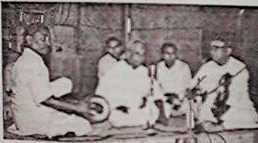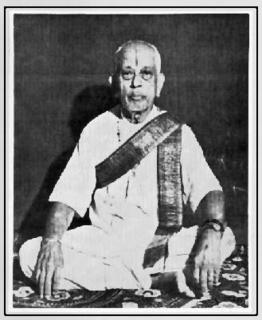Sangeeta Ratnakara Ariyakudi
Dr. K. Rohiniprasad



Musical performances in Carnatic style usually feature more items or ragas compared to Hindustani concert format that treats fewer ragas more elaborately. This trend was mainly initiated by Ariyakudi Ramanuja Iyengar (1890-1967). Born into a family of astrologers in Ariyakkudi near Karaikudi (Tamilnadu), Ramanuja was told early that his destiny lay in music. Accordingly he took early lessons in music from Pudukottai Malayappaier and later from Namakkal Narasimha Iyengar and Ramanthapuram (Poochi) Srinivasa Iyengar. He made his debut at the Tyagaraja Aradhana in 1918 and started giving concerts in
Ramanuja Iyengar was influenced by great performers like Tirukkodikaval Krishna Iyer, Tiruchi Govindasami Pillai, Sarabha Sastri, Sakharam Rao, Vina Dhanammal and others. Traditional Carnatic music concerts consisted of elaborate and leisurely renderings better suited to audiences with a lot of time to spare. In the early decades of the twentieth century classical music moved from the royal courts and temples to the public platform. In a metropolis like
Having studied the works of Vaggeyakaras and musicologists like Purandaradasa, Ramamathya, Venkatamakhi, Akalanka, Govindacharya and others, he devised a format for his concerts keeping in mind the variety that was required. He realised that the performer must be conscious of his strengths and weaknesses and keep the listeners spell-bound, making them stay on to the very end, asking for more. His guiding principle was to provide a wider choice of classical items. A good knowledge of the lyric was needed to express emotions. He strove to elevate and educate the listeners and improve their tastes. To this end, his fare would typically consist of short and crisp alapana of two or three of the ragas with. Kalpana-svaras limited and restricted to a few items based on different talas, with some measure of niraval (improvised variations in the rendering of the song). Towards the end of his performance he would include popular items from Gita Govinda, Taranga, Kshetrayya, Arunachala Kavi, Nandanar Charitram, Muthu Tandavar Padam, Vedanayakam Pillai's compositions, Kavikunjara Bharathi's pieces, Tiruvachakam, Tevaram, Prabhandam, Arutpas or Patrinthar or Thayumanavar and Subramanya Bharati. He chose a well-tuned tambura for sruti in his concerts instead of harmonium. He disproved the myth that traditional music was not pleasing to the ear. Soon others began to follow his style of presentation that brought classical music closer and made it popular with the layman.
Ariyakudi attained great reputation that lasted for over half a century. His style was such that he would not pause for long between songs or between the stanzas of a composition. Even his alapana was fast-paced. Nevertheless his poise and presentation were great. On one occasion his eminent contemporary G.N.Balasubramaniam prostrated himself at his feet out of respect. Ariyakudi could play the mridangam and became a close friend and admirer of Palghat Mani Iyer, the great mridanga vidwan. The liking and respect were mutual. When Ariyakudi passed away in 1967, Mani Iyer said "In his death, what has been lost is not only his great music but also my inspiration for creativity". Many awards and titles were bestowed upon him including Padmabhushan, Sangita Kalanidhi (Music Academy, Madras 1938), Gayaka Shikhamani (Mysore Durbar), Sangita Kala Shikhamani (Indian Fine Arts Society,


0 Comments:
Post a Comment
<< Home